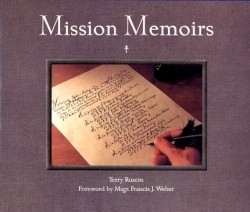Mission Memoirs
A Collection of Photographs Illustrations and Late Twentieth-century Reflections on California's Past
On a miserable December day in southern California, designer and art director Terry Ruscin drove to the church at Mission San Luis, Rey de Francia to hear a performance of Handel’s Messiah. The music was familiar enough, but for Ruscin it took on a new dimension when amplified by the church’s nearly 200-year-old distempered walls. In a moment of epiphany, he “sensed that this place and others like it could teach [one] things—about architecture, history, art, and, most importantly, human achievement.”
To that end, Ruscin set out on a personal and artistic quest to photograph and write about all twenty-one of California’s missions. He not only met but exceeded this goal, as he visited several mission-affiliated asistencias (extensions or substations), presidios (forts) and estancias (farm and ranch outposts).
Although many mission sites are still used by the Roman Catholic Church, a large number of the original churches and surrounding buildings have been removed, replaced or renovated to reflect later trends. The ruins of the at Santa Margarita de Cortona, ten miles from San Luis Obispo, are entirely hidden beneath a large modern barn. Other sites bear even fewer traces of the social and spiritual centers they were in the eighteenth and nineteenth centuries. Taking each monument in its geographic order, Ruscin depicts these shadowy ruins as mindfully as he does the flourishing parish churches at Santa Clara de AsÃs and San Juan Batista.
Ruscin has organized his presentation geographically, starting at San Diego de Alcala in the south, and ending at San Francisco Solano in the north. This itinerary reinforces something obvious but resonant. Looking at one of the maps, one sees that the names of these frontier churches are not only a litany of saints, but a litany of familiar place-names: San Francisco, San Rafael, San Luis Rey, San Fernando, San Jose, Santa Cruz. The spiritual homesteading efforts of Spanish missionary Brother Junipero Serra and his followers between 1769 and 1823 were a resounding achievement, at least in secular terms. Many of these tiny religious settlements, established in the name of Spain, are prosperous cities and towns today, at the cusp of the twenty-first century.
This volume is filled with historical vignettes about the Spanish missionaries, the native Californians, and all the other groups who have left their mark on the missions since their founding. Ruscin’s account, however, is more memoir than history. He states his premise in the book’s prologue: it is a diary of his journey. It is not a history text, nor does it attempt to document the lives of the missionaries and their converts. Frequently he writes from the perspective of an artist; at other times he speaks as a modern man fascinated by life as it was lived in an earlier time. Although he appears emotionally and intellectually engaged by the Catholic faith as embodied by the missions, his perspective is secular.
Ruscin provides a variety of resources for readers who would like to know more about the California missions. A three-page bibliography offers ample resources for readers who are inspired to study the missions—or a particular edifice—in more depth. Many salient topics—including some great historical trivia—are discussed in the multilingual glossary and appendices at the back of the book.
Reviewed by
Laurene Sorensen
Disclosure: This article is not an endorsement, but a review. The publisher of this book provided free copies of the book to have their book reviewed by a professional reviewer. No fee was paid by the publisher for this review. Foreword Reviews only recommends books that we love. Foreword Magazine, Inc. is disclosing this in accordance with the Federal Trade Commission’s 16 CFR, Part 255.

